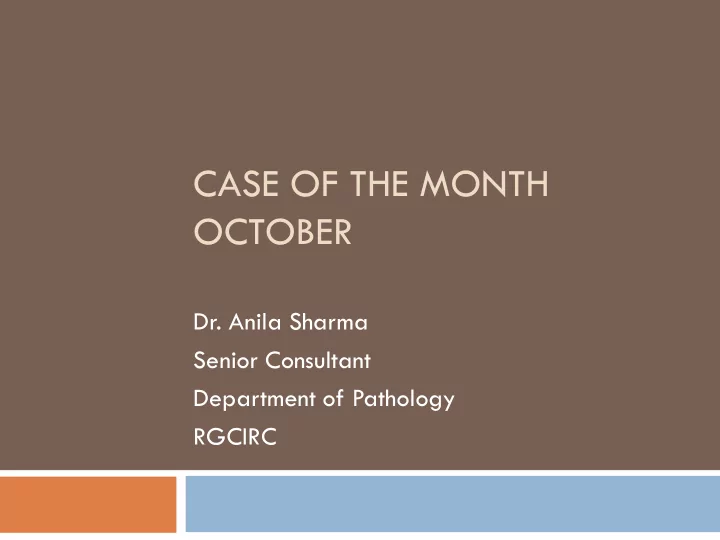

CASE OF THE MONTH OCTOBER Dr. Anila Sharma Senior Consultant Department of Pathology RGCIRC
History 55 years male Known case of DM Headache x 6-7 months Giddiness Altered consciousness
Investigations MRI Posterior fossa lesion with hydrocephalous Calcified non enhancing lesion, measuring 2.6 x 2.5 cm in midline cerebellum and fourth ventricle Other investigations were with in normal limits
Management Suboccipital craniotomy and decompression of tumour with external ventricular drain placement Intra-operative findings were suggestive of solid cystic tumor arising from fourth ventricle which was whitish in appearance Tumour was removed in piecemeal
H & E 40x
H & E 40x
H & E 200x
H & E 400x H & E 200x
Morphological features Biphasic tumour neurocytic glial component The neurocytic component consists of ring shaped neurocytic rosette around eosinophilic neuropil cores. tumor cells have spherical nuclei scant cytoplasm background is myxoid The glial component shows spindle to stellate shaped nuclei with dense chromatin in a fibrillary background rosenthal fibers, hemosiderin deposits are seen focally No necrosis or calcification seen.
Differential diagnosis Based on glial component morphology Pilocytic astrocytoma Dysembryoplastic neuroepithelial tumour Based on neurocytic rosettes Glioneuronal tumor with neuropil like islands Rosette forming glioneuronal tumour (RGNT) Ependymoma
GFAP 400x
SYNAPTOPHYSIN 400x
S-100 400x
Ki- 67 400x
Summary of case Tumour in cerebellum and fourth ventricle Histologically : biphasic tumour neurocytic and glial component On IHC synaptophysin positive in neuropil S 100 positive in neurocytic cells GFAP positive in glial component
Final diagnosis Rosette Forming Glioneuronal Tumor WHO grade 1
Discussion 2007 WHO classification of CNS tumors “ rosette-forming glioneuronal tumors of the fourth ventricle” Presence of this entity in various anatomical locations cerebellar hemisphere and/or vermis , pineal region, chiasma, lateral and third ventricle, hypothalamus, and spinal cord 2016 WHO classification renamed to “rosette -forming glioneuronal tumors” histologically classified as grade I
Rare entity only 150 cases of RGNTs have been described Young adults with female predominance are mostly affected Generally well demarcated sometimes minor to moderate infiltration Histopathologic examination Biphasic neurocytic and glial architectures Oligodendroglial-like cells Cellular atypia, mitotic figures, necrosis, and calcification are rarely visible
Genetic testing of RGNTs may reveal mutations in PIK3CA and FGFR1 genes Although RGNTs are WHO grade I tumors and are considered benign Some reports have presented cases with intra- ventricular dissemination and rapid progression Management is usually through surgery with gross total resection (GTR) providing better prognosis
Thank you
Recommend
More recommend